Topic: Transparent tissues: eyes, bodies and reflective surfaces
Read on if you want to know about the numerous animal equivalents to the invisible man...
We are nearly all very familiar with transparent tissues, because without them our eyes would not work. The lens and cornea depend critically on the crystallin proteins, an excellent example of molecular convergence. Transparency is, however, much more widespread. It is useful as a means of camouflage in habitats where an escape from visual predators is otherwise impossible, such as the open ocean, which lacks structures to match or hide behind. There are also examples of a more active use of transparency, such as in the cnidarian Aglama okeni that is mostly transparent but has pigmented regions mimicking fish larvae or copepods to lure prey. Some other cnidarians can suddenly change from being transparent to being opaque, possibly as a defensive startle response.
Occurrence of transparency
Marine animals
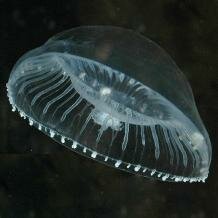 Transparency is mainly found in pelagic animals, where unsurprisingly it is a common trait. The major advantage of transparency in the open water is that it functions effectively as camouflage at all depths and from all viewpoints. It has thus evolved independently in numerous, phylogenetically diverse groups. Best known are probably the Cnidaria, where transparency is prevalent in the box jellyfish (Cubozoa), Anthomedusa and Siphonophora.
Transparency is mainly found in pelagic animals, where unsurprisingly it is a common trait. The major advantage of transparency in the open water is that it functions effectively as camouflage at all depths and from all viewpoints. It has thus evolved independently in numerous, phylogenetically diverse groups. Best known are probably the Cnidaria, where transparency is prevalent in the box jellyfish (Cubozoa), Anthomedusa and Siphonophora. 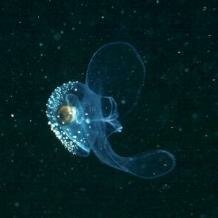 Among gastropod molluscs, the heteropods, pteropods and nudibranchs in the family Phylliroidae are highly transparent, but amongst the cephalopods only a few display significant transparency (the aptly named glass octopus Vitreledonella richardi, the telescope octopus Amphitretus pelagicus, the glass squids in the family Cranchiidae and some chirotheudid squids). The only crustacean group that is dominated by transparent species are the hyperiid amphipods,
Among gastropod molluscs, the heteropods, pteropods and nudibranchs in the family Phylliroidae are highly transparent, but amongst the cephalopods only a few display significant transparency (the aptly named glass octopus Vitreledonella richardi, the telescope octopus Amphitretus pelagicus, the glass squids in the family Cranchiidae and some chirotheudid squids). The only crustacean group that is dominated by transparent species are the hyperiid amphipods,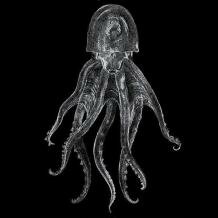 which often enhance their transparency by special modifications.
which often enhance their transparency by special modifications.
Other transparent taxa include comb jellies (Ctenophora), thaliacean tunicates (Salpida and Doliolida), arrow worms (Chaetognatha) and several genera of ribbon worms (Nemertea),  where, however, the benefit of transparency is often diminished by pigmented food in the branched gut. A number of polychaete annelids are also transparent. The remarkable poeobiidid annelids have their body encased in a transparent gelatinous sheath and arguably possess the most radically altered of annelid body plans. More orthodox annelids that are transparent include the tomopterids and the alciopids
where, however, the benefit of transparency is often diminished by pigmented food in the branched gut. A number of polychaete annelids are also transparent. The remarkable poeobiidid annelids have their body encased in a transparent gelatinous sheath and arguably possess the most radically altered of annelid body plans. More orthodox annelids that are transparent include the tomopterids and the alciopids (which are furthermore interesting in terms of convergence, because they have independently evolved camera eyes). The effectiveness of alciopid transparency is tellingly conveyed by Quentin Bone when he writes “all that can be seen of some alciopid polychaetes […] are a pair of crimson eyes and a single row of black spots apparently swimming around independently with any corporeal link” (Bone 2005, Journal of the Marine Biological Association of the United Kingdom, vol. 85, p. 641). The pelagic larvae of many teleost fish are often highly transparent as well, but typically lose their transparency upon metamorphosis.
(which are furthermore interesting in terms of convergence, because they have independently evolved camera eyes). The effectiveness of alciopid transparency is tellingly conveyed by Quentin Bone when he writes “all that can be seen of some alciopid polychaetes […] are a pair of crimson eyes and a single row of black spots apparently swimming around independently with any corporeal link” (Bone 2005, Journal of the Marine Biological Association of the United Kingdom, vol. 85, p. 641). The pelagic larvae of many teleost fish are often highly transparent as well, but typically lose their transparency upon metamorphosis.
Freshwater animals
Transparency is quite common in freshwater crustaceans, but most species are smaller than 5 mm. Some freshwater teleosts, such as the appropriately named Asiatic glassfishes (Ambassidae),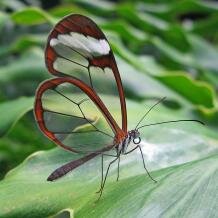 the glass catfish (Kryptopterus bicirrhis) and the glass knifefish (Eigenmannia virescens), are the only transparent vertebrates.
the glass catfish (Kryptopterus bicirrhis) and the glass knifefish (Eigenmannia virescens), are the only transparent vertebrates.
Terrestrial animals
In terrestrial environments, transparency is remarkably scarce. The only notable examples are some butterflies with transparent wings (e.g. glasswing Greta oto and pellucid hawk moth Cephonodes hylas) that are likely to provide some protection from visual predators or parasites. Despite their name, glass frogs (Centrolenidae) merely have a transparent ventral side, but a pigmented dorsal side and opaque organs.
Physical basis of transparency
Although important in nature, the phenomenon of transparency is not particularly well understood. To achieve transparency, a structure must allow light to pass through, i.e. neither scatter nor absorb it. Light scattering, however, is not easy to avoid. It requires a homogenous refractive index, but different components of the body usually have different refractive indices. The solution seems to lie in the structural organisation of features. Most adaptations are ultrastructural, but there might also be anatomical modifications.
Flattening
As the attenuation of light is exponential, extreme flattening of the body helps to achieve transparency (and might also have other functions, such as enhanced locomotion). This strategy is employed by many organisms (e.g. ctenophores, phylliroid nudibranchs and some fish larvae) but taken to extremes by the larvae of spiny lobsters (Palinurus), which are about 50 mm across but not even 1mm thick!
Reflective surfaces and counterillumination
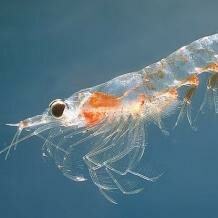 Some structures, basically eyes and guts, cannot be made transparent, but many animals have come up with clever solutions to this problem. Heteropod molluscs employ reflective surfaces as mirrors,
Some structures, basically eyes and guts, cannot be made transparent, but many animals have come up with clever solutions to this problem. Heteropod molluscs employ reflective surfaces as mirrors, 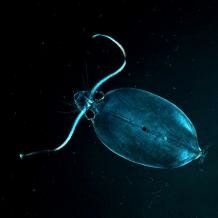 which by reflecting only the surrounding ocean render the eye invisible! Glass squids mask the shadows of their eyes seen from below by counterilluminating bioluminescence, and some shrimps (e.g. Sergestes similis) use a similar strategy to hide their guts. A number of animals (e.g. some heteropods, glass squids and hyperiid amphipods) have elongated guts that are vertically oriented and sometimes even reflective, thus minimising gut profile and contrast. Chaoborus larvae avoid the problem in the first place by simply ingesting only clear food.
which by reflecting only the surrounding ocean render the eye invisible! Glass squids mask the shadows of their eyes seen from below by counterilluminating bioluminescence, and some shrimps (e.g. Sergestes similis) use a similar strategy to hide their guts. A number of animals (e.g. some heteropods, glass squids and hyperiid amphipods) have elongated guts that are vertically oriented and sometimes even reflective, thus minimising gut profile and contrast. Chaoborus larvae avoid the problem in the first place by simply ingesting only clear food.
Ultrastructures
A particularly ingenious method of achieving transparency is to ensure that the surface of the animal is not smooth but studded with minute pimples. Such small protrusions reduce reflectance, because they mimic a material of intermediate refractive properties and thus work as a kind of impedance transformer. At the tips, the refractive index equals that of the surrounding medium and at the base, the index is the same as that of the animal. This arrangement is also found in the compound eyes of many mainly nocturnal insects (hence the term “moth eye” surface, technically termed a corneal nipple array), where it probably serves to camouflage the eyes and enhance image formation. Extracellular and cellular tissues may become transparent in different ways. In some instances, it seems to be similar to how the lens of the eye achieves transparency by virtue of close packing of crystallins. In other cases, it is likely that components of the cells are so organised in size and by clustering to minimise the degree of light scattering.
Hazardous transparency?
 There is little doubt that, by conferring relative invisibility, transparency helps with protecting potential prey and assisting predators to approach unseen. However, there is a serious downside to being transparent – ultraviolet radiation damage. This might help to explain why transparency is relatively rare in aquatic organisms living near the surface and, particularly, in terrestrial animals. However, other factors probably contribute to the scarcity of terrestrial transparency, such as the low refractive index of air (which increases surface reflection dramatically) and gravity (skeletal support structures are often opaque).
There is little doubt that, by conferring relative invisibility, transparency helps with protecting potential prey and assisting predators to approach unseen. However, there is a serious downside to being transparent – ultraviolet radiation damage. This might help to explain why transparency is relatively rare in aquatic organisms living near the surface and, particularly, in terrestrial animals. However, other factors probably contribute to the scarcity of terrestrial transparency, such as the low refractive index of air (which increases surface reflection dramatically) and gravity (skeletal support structures are often opaque).
As water provides only an imperfect screen against UV radiation, aquatic animals at greater depth are also at risk and need to protect themselves from UV radiation,  typically by UV-absorbing pigments (not surprisingly, similar compounds are used in UV absorption in eye lenses). Such pigmentation, however, increases visibility at UV wavelengths and thus facilitates detection by UV-sensitive predators (or prey). Some freshwater organisms are able to largely avoid this conflict between camouflage and protection by, for example, pigmentation that is induced in response to predation or by the limitation of pigmentation to essential organs.
typically by UV-absorbing pigments (not surprisingly, similar compounds are used in UV absorption in eye lenses). Such pigmentation, however, increases visibility at UV wavelengths and thus facilitates detection by UV-sensitive predators (or prey). Some freshwater organisms are able to largely avoid this conflict between camouflage and protection by, for example, pigmentation that is induced in response to predation or by the limitation of pigmentation to essential organs.
UV visibility is not the only hazard facing transparent animals, because they also become potentially visible in polarised light. As transparent objects affect the polarisation of light, polarisation vision can increase the contrast of transparent structures, and many crustaceans and cephalopods are able to detect polarised light. Finally, a behavioural adaptation related to the angle from which an object is viewed might help to break the camouflage of transparent animals.
Cite this web page
Map of Life - "Transparent tissues: eyes, bodies and reflective surfaces"
https://mapoflife.org/topics/topic_82_transparent-tissues-eyes-bodies-and-reflective-surfaces/
May 6, 2021

